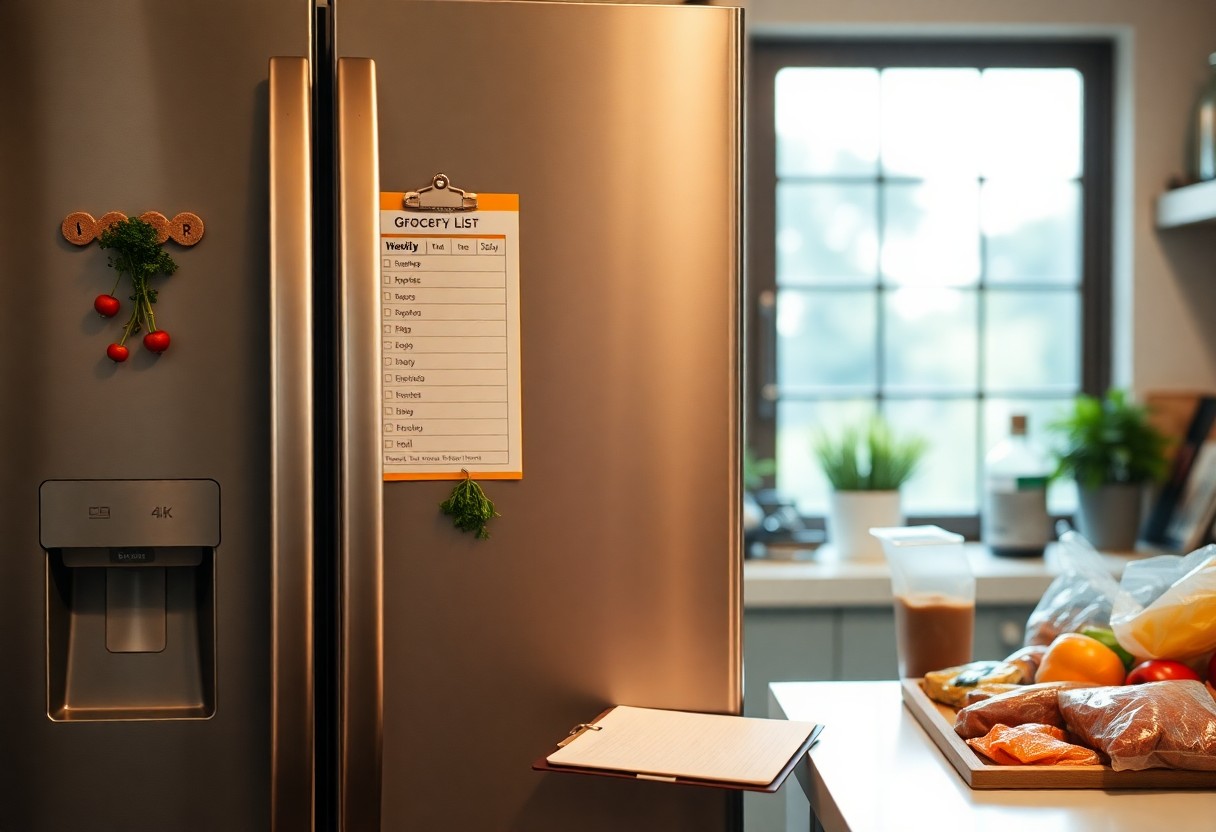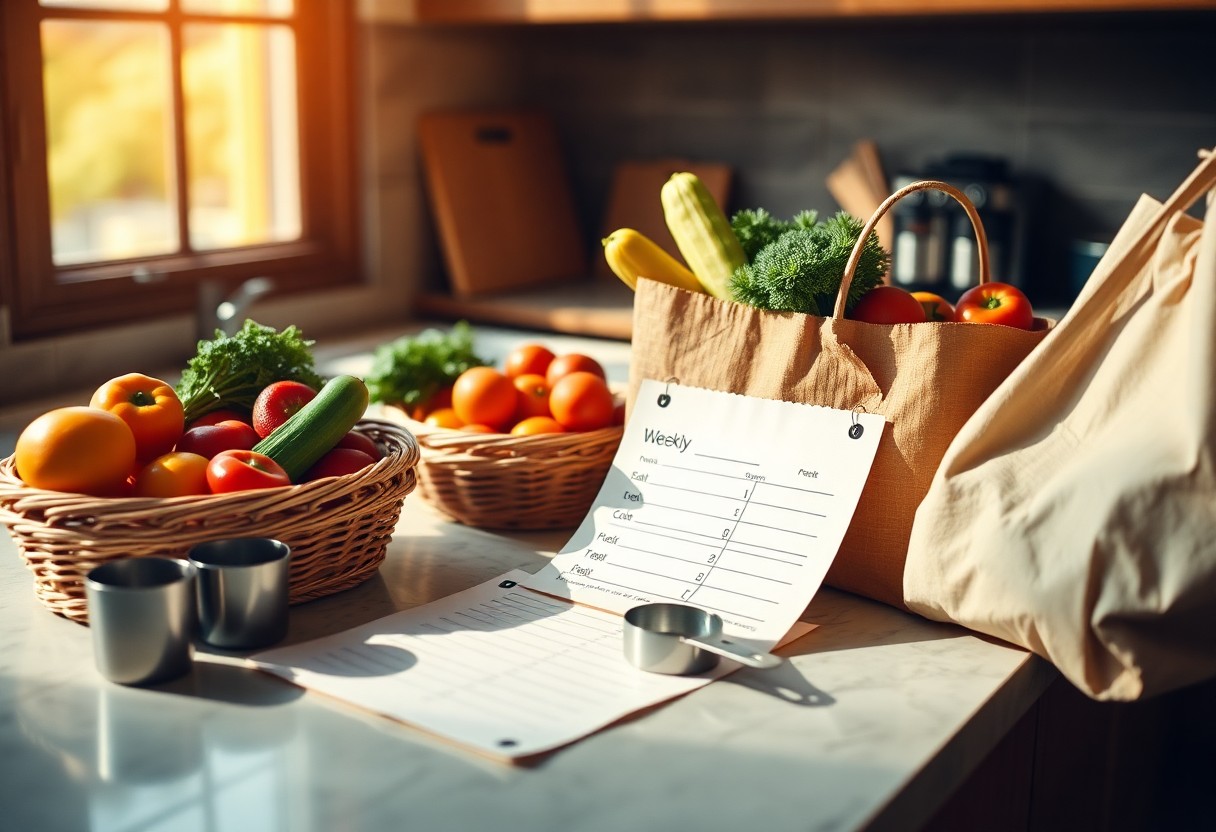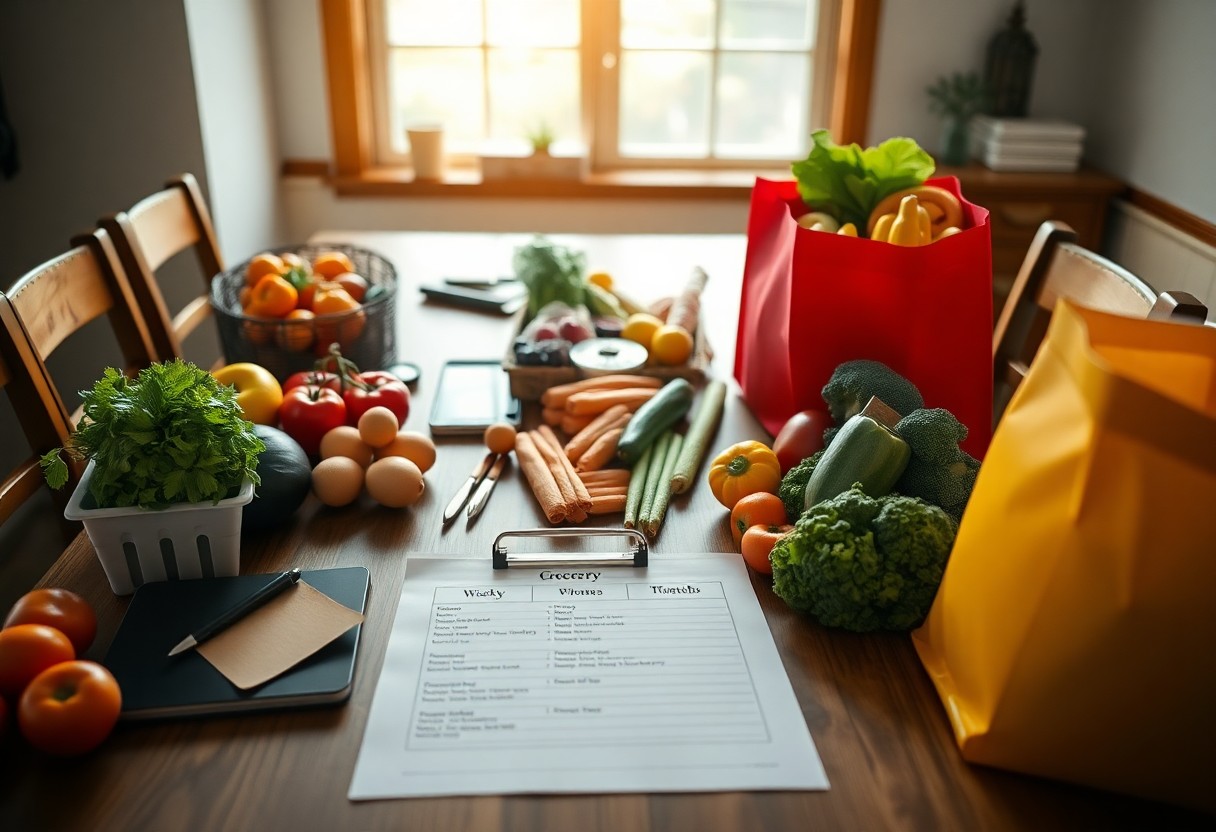Most people struggle to create a grocery list that truly meets their needs, leading to food waste and unplanned purchases. By developing a smart strategy, you can save time and money while ensuring you have the ingredients necessary for balanced meals. This guide will help you plan meals efficiently and maximize your shopping experience. Discover valuable tips and resources for effective planning through Food Shopping and Meal Planning to streamline your grocery routine.
Understanding Your Needs
To build an effective grocery list, assessing your personal needs and preferences is necessary. Focus on your _weekly meal plan_ and any dietary restrictions that influence your choices. Consider the number of meals you’ll prepare, the ingredients required for those dishes, and how they align with your eating habits. This ensures efficiency while minimizing food waste, aligning your purchases closely with what you actually consume.
How-to Assess Your Weekly Meal Plan
Begin by outlining your meals for the week, incorporating a mix of nutritious foods and favorite dishes. Evaluate existing ingredients in your pantry to prevent overbuying, and adjust your list based on what you already have. Mapping out each day helps you visualize portion sizes and necessary items, promoting a tailored approach to grocery shopping that reduces excess.
Tips for Identifying Dietary Preferences
Recognizing your dietary preferences can streamline your grocery list. Explore various food categories—such as protein, grains, and vegetables—to see what you enjoy most. Keep track of items that resonate with your taste buds and those that do not. Significantly, having a collection of recipes aligned with your preferences makes shopping easier. Thou art encouraged to explore seasonal produce, as this can inspire creativity and enhance flavor.
Identifying dietary preferences goes beyond just liking certain flavors. Spend time reflecting on your health goals or lifestyle choices. For instance, if you’re aiming for a plant-based diet or trying to eliminate certain allergens, make notes on necessary ingredients that fit this paradigm. Monitor how different foods make you feel and adjust your list accordingly. Thou should pay attention to labels and ingredient lists to ensure your choices align with your goals.
- Reflect on health goals
- Seasonal produce boosts flavor
- Track ingredient effects
Selecting Essential Ingredients
Creating a well-rounded grocery list requires selecting crucial ingredients to meet your meal planning needs. Focus on your go-to staples like grains, legumes, fats, and seasonings, while adapting them according to your weekly menu. This selection not only enhances flavor and variety but also maximizes nutrition in your meals.
How to Choose Fresh Produce
Picking fresh produce involves examining the color, texture, and firmness of fruits and vegetables. Look for vibrant colors and avoid any spots, blemishes, or signs of mold. Seasonal produce tends to be fresher and more affordable, allowing you to experiment with different flavors each week.
Tips for Choosing Protein Sources
Opt for a mix of protein sources such as meat, fish, legumes, and dairy to meet your dietary needs. Fresh, local options like grass-fed beef or sustainably caught fish provide higher nutrient density. Frozen varieties can offer convenience and longevity without sacrificing quality. This approach not only diversifies your meals but also supports balanced nutrition.
- Emphasize diversity in your protein sources.
- Prioritize local and fresh options for better quality.
- Consider plant-based proteins for additional health benefits.
- Utilize frozen proteins to extend shelf life.
- This will ensure you always have nutritious options on hand.
Explore various protein sources to enrich your meals while considering your budget and preferences. Incorporate items like canned beans, lentils, and tofu to complement fresh meats or fish, giving you flexibility during the week. If possible, choose organic or grass-fed options to maximize health benefits and flavor. This rounded selection can streamline your cooking process.
- Incorporate canned and frozen options when fresh is unavailable.
- Rotate between different animal and plant proteins.
- Evaluate portion sizes to prevent food waste.
- Invest in high-quality protein snacking options.
- This helps maintain variety and keeps your meals exciting.

Organizing Your Grocery List
Organizing your grocery list enhances your shopping efficiency and helps prevent impulse purchases. Arrange items by category, such as produce, dairy, grains, and proteins, to streamline your shopping experience. Keeping your list structured allows you to navigate the store systematically, reducing time spent wandering and enhancing productivity. This orderly approach not only simplifies the shopping process but also supports effective meal planning, ensuring you buy only what you need.
How-to Categorize Items
To categorize your grocery list effectively, divide items into distinct groups based on the layout of your store. Common categories include fruits, vegetables, meat, dairy, grains, and snacks. By grouping similar items together, you can easily locate them while shopping, minimizing the time spent and helping you avoid missing vital ingredients. Tailor your categories to your shopping habits and store layout for even greater efficiency.
Tips for Efficient Shopping
Maximizing your shopping efficiency involves employing several smart strategies. Always shop during off-peak hours to avoid crowds and allow ample time to explore. Bringing your own reusable bags not only helps the environment but also keeps you organized. Using a shopping app can streamline your list and provide pricing information, ensuring you stick to your budget. Lastly, sticking to your list is key for preventing unnecessary purchases. Any distractions can derail your goal of efficient shopping.
- shopping app
- reusable bags
- browsing
- efficiency
- budget
Implementing these tips during your grocery trips can transform the way you shop. Opt for a systematic route through the store based on your categories to keep the flow going. Consider checking for sales or discounts on items from your list before heading out, saving money without extra effort. Many grocery stores have loyalty programs that reward repeat customers. Any delays can impact your schedule and discourage consistent shopping habits.
- systematic route
- sales
- discounts
- loyalty programs
- customer rewards
Maximizing Savings
Maximizing savings on groceries involves strategic planning and smart shopping techniques. By comparing prices, utilizing coupons, and taking advantage of sales, you can significantly reduce your grocery expenses. Always check for store promotions and loyalty programs that can enhance your savings further. Planning meals around items on sale will not only save you money but also minimize food waste.
How-to Compare Prices
| Check Store Flyers | Review weekly ads for discounts and promotions. |
| Use Price Comparison Apps | Utilize apps to find the best prices nearby. |
| Online Shopping | Compare prices between online grocery services. |
Tips for Utilizing Coupons and Sales
Maximize your grocery budget by effectively using coupons and sales. Start by organizing your coupons according to the products on your list. Many stores offer double coupon days or exclusive discounts for loyalty members, which can amplify savings. Check apps and websites for additional coupon options before heading out. Utilize price matching policies at some retailers to get the best deal available on your list.
- Organize your coupons according to your list.
- Utilize store loyalty programs for extra discounts.
- Check apps for savings opportunities before shopping.
Using coupons effectively also involves planning ahead. Set aside time each week to browse local flyers and online coupon sites. Create a folder or app to keep track of active coupons, ensuring you don’t miss out on savings at checkout. Consider stacking manufacturer and store coupons for maximum benefit. Recognizing the value of each coupon can lead to significant savings over time.
- Set aside time weekly to check for coupons.
- Create a dedicated folder for your coupons.
- Stack manufacturer and store coupons for savings.

Reducing Food Waste
Reducing food waste starts with thoughtful planning and organization. By understanding your consumption patterns and carefully selecting groceries, you can ensure that less food goes to waste. This not only benefits your wallet but also contributes to sustainability. Tracking expiry dates, shopping in bulk for non-perishables, and incorporating seasonal produce can make a significant impact on maintaining freshness and minimizing waste. Assume that small changes in your shopping habits accumulate to a larger reduction in overall food waste.
How to Store Food Properly
Effective food storage is vital in prolonging the life of your groceries. Use airtight containers for dry goods to keep them fresh, and store fruits and vegetables in the appropriate crisper drawers to maintain their nutrients. Adapt your storage techniques based on the types of food: refrigeration slows the ripening of certain items, while freezing can significantly extend the shelf life of leftovers. When food is stored properly, you increase the chances of enjoying every ingredient without the hassle of spoilage. Assume that optimal storage practices will lead to less food waste.
Tips for Using Leftovers
Using leftovers creatively can minimize food waste and save you time. Repurposing remnants from previous meals into new dishes not only reduces waste but adds variety to your weekly menu. Transform roasted vegetables into a hearty soup or use stale bread for a delicious bread pudding. Plan meals around your leftovers, ensuring they are utilized within a reasonable timeframe to maintain freshness. Assume that incorporating leftovers into your meal planning can significantly reduce waste and enhance your cooking efficiency.
- Repurposing leftovers for new dishes
- Meal planning around remaining ingredients
- Maximizing freshness by consuming them in a timely manner
- Creativity in the kitchen
Consider using any leftover ingredients in sauces, salads, or grain dishes, which allows you to create new flavor combinations. For instance, adding leftover chicken to a stir-fry with fresh vegetables can rejuvenate a mid-week meal. Mixing various grains can add texture and nutrition, while also putting to use any remaining components. Assume that strategic use of leftovers promotes both culinary creativity and the reduction of food waste.
- Creating new flavor combinations
- Enhancing nutrition by mixing different ingredients
- Encouraging creativity in meal preparation
- Reducing food waste significantly

Adjusting Your List
Flexibility is key in maintaining a grocery list that serves your needs. Regularly revisit the contents and adjust based on availability, preferences, and dietary changes. For example, incorporating a new meal prep strategy, like I Tried the 5-4-3-2-1 Grocery Method and I’m Never Going …, can make your list more effective by focusing on fewer items and reducing waste.
How-to Revise Based on Seasonal Changes
Seasonal ingredients can elevate your meals while being more cost-effective. Track seasonal produce and adjust your list accordingly, ensuring freshness and nutritional value. For instance, shift to root vegetables in winter while embracing berries in the summer. Leverage local farmers’ markets for the freshest offerings, which can significantly enhance your meals.
Tips for Incorporating New Recipes
Exploring new recipes adds variety to your meal plan. Start by selecting a few new dishes weekly, then analyze the ingredients needed for each. This method will naturally expand your grocery list and help you discover previously untried flavors. Keeping a dedicated section for new recipes on your list encourages variety while reducing the chances of repetitiveness.
- Commit to weekly recipes that inspire you.
- Break down ingredients into manageable sections.
- Explore cooking websites for diverse meal ideas.
Recognizing ingredient overlap between recipes can streamline your shopping, ensuring efficiency. Collecting recipes from various cuisines may also expose you to new techniques, ultimately enriching your culinary skills.
- Plan your weekly meals with new dishes.
- Keep an ongoing recipe list for inspiration.
- Try ingredient substitutions for creativity.
Recognizing how new ingredients can fit into multiple meals enriches your pantry while keeping your cooking exciting. By diversifying your meals, you enhance not only your cooking skills but also the enjoyment of the dining experience.
Final Words
Hence, by following a structured approach to create your weekly grocery list, you can ensure that your meals are planned efficiently, reducing food waste while maximizing your budget. Start by assessing your meal plans, inventory, and shopping frequency. Use categories for organization to streamline your shopping experience and stick to your list to prevent impulse buys. By committing to this method, you’re not just saving time and money but also cultivating healthier eating habits that align with your lifestyle.
FAQ
Q: How do I start creating my weekly grocery list?
A: Begin by planning your meals for the week. Choose recipes that use similar ingredients to maximize your purchases. Make a list of these meals and check your pantry for items you already have.
Q: How can I ensure I’m not wasting food?
A: To minimize waste, plan meals around ingredients that can be used multiple times. Opt for recipes that incorporate leftover ingredients from previous meals. Consider portion sizes to match your household needs.
Q: What should I include in my grocery list?
A: Your grocery list should include all necessary ingredients for your planned meals, snacks, and pantry staples. Organize your list by categories such as produce, dairy, grains, and proteins for efficient shopping.
Q: How often should I update my grocery list?
A: Update your grocery list weekly, or whenever you find yourself running low on imperative items. Maintain a running list throughout the week to track what you need as you use up ingredients.
Q: Are there any tools to help with grocery list creation?
A: Yes, apps and websites can assist with meal planning and grocery list creation. Some allow you to input recipes, track inventory, and categorize your list, making the process seamless and efficient.